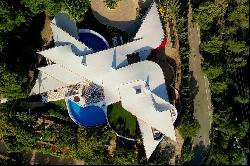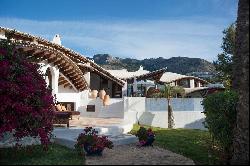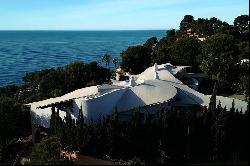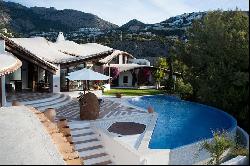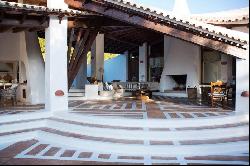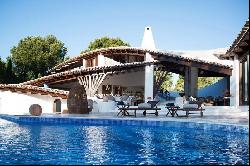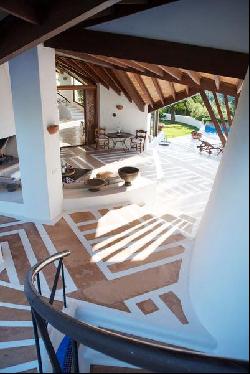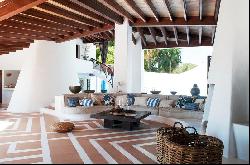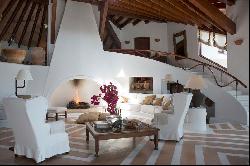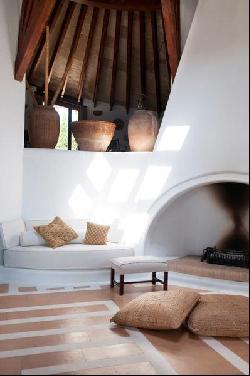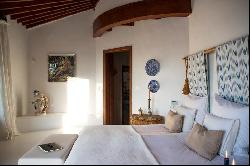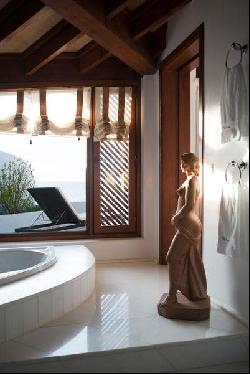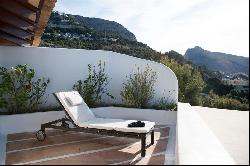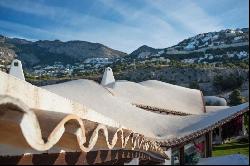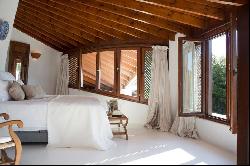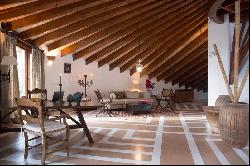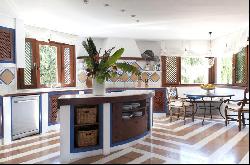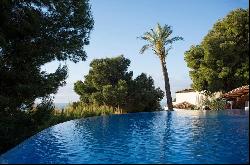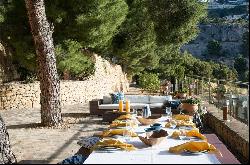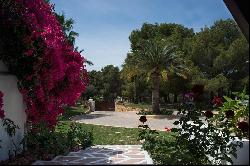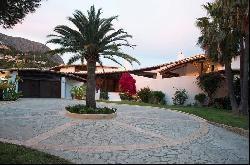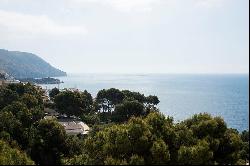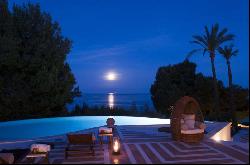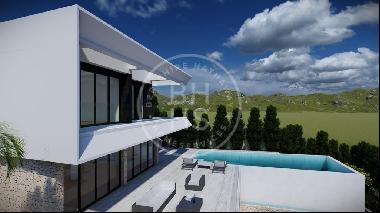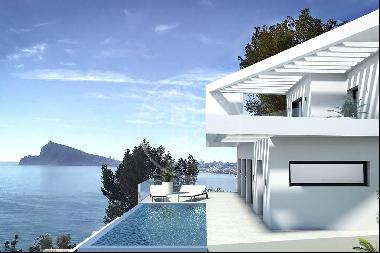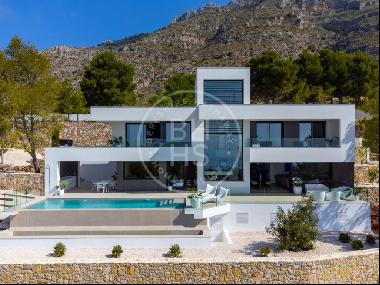出售, Euro 5,750,000
Altea Hills, Altea, 阿利坎特省-瓦伦西亚自治区, 西班牙
楼盘类型 : 私人别墅
楼盘设计 : 当代式
建筑面积 : 7,535 ft² / 700 m²
实用面积 : 10,764 ft² / 1,000 m²
占地面积 : 43,056 ft² / 4,000 m² 转换占地面积
卧室 : 5
浴室 : 5
浴室(企缸) : N/A
MLS#: N/A
楼盘简介
At Brinkman Fine Real Estate, we often say that a house is more than just a house. It is a home, a sanctuary; it is family; it is character, an identity, a friendship. And sometimes, it is also a work of art.
Villa La Gaviota is such a house – more than a masterpiece of architecture, it is a soaring sculptural expanse that pays tribute to the landscape and the sea, and the splendor that are the Altea Hills of Alicante. Appearing from above like a white flock of seagulls on the verge of flight, from within, La Gaviota nearly dances, a choreography of space and air and shelter, of light and shade and form.
“I think architecture, for good or bad, is very influential on human living,” explains Alberto Rubio, who designed La Gaviota – one of the first of his so-called “bird houses” – in 1998. “The idea is that a sculpture is thought of as something to be seen, but not lived in. My idea is that people have to live in the sculpture, and when you make your life in a sculpture house like this, then I believe your life changes.”
If the best art is a melding of inspiration and harmony, so, too, is a life lived inside such a work of art – a sculpture as house, as home, with the inspiring lines and harmonious curves, the gentle hues and sweeping embrace that is Villa La Gaviota.
And, too, the house itself changes with the presence of those within, as shadows and light across the hours create new lines, new contours, amid the rising wings and arabesques of space — shadows and contours that reflect the motions of within its rooms, of families that grow over the years, of groups who gather in celebration. Their forms reform both the house within the landscape – and the landscape within the house. “There is no inside or outside for me,” says Rubio. “The whole thing is: the content and the form are the same thing. The house has to be integrated, it has to be holistic, from every corner of the house to the center.
No inside, no outside: like an Earth Work, the sculpture – the house – becomes one with the landscape, the earth, with the skyline of the mountains, the cliffs over the sea, the infinity of sky and air. “They open their wings to the view,” he says. “The bird is flying towards the views, always. It doesn’t fly backward. Always, it flies only forward.”
The Home And Its Creator
Born in Montevideo, Uruguay in 1954, Alberto Rubio moved to Mallorca at the age of 25. Much of his work reflects the joyous freedom of the region’s landscape; but it has been influenced, too, by his widespread travels, and by his innate understanding of the links that bind architecture, landscape, and culture. In this, he has said, he found particular glory in the architecture of Mexico, which he believes is “the best architecture in the world,” thanks to its spectacular colour, exquisite local craftsmanship, and careful detail.
La Gaviota, with its 700 square meters of living space stretched over 4,000 square meters of gardens and cliffs overlooking the sea, celebrates the marriage of Rubio’s loves – the craftsmanship and attention to colour and detail he reveres in the architecture of Mexico with the sweeping space and freedom of Altea Hills. The white and terra cotta hues of the home pay tribute, he says, to the colours of the Mediterranean: “They are the colour of the sea, the sky, the rocks,” he explained. But the use of colour itself, along with carefully crafted and often surprising details, are a homage to Mexico. Here and there throughout the house, for instance, an unexpected wave appears and reappears in the woodwork, a feature that echoes throughout the rooms in walls, in shelving, even in furnishings. “Little things can be so meaningful,” says Rubio. “So the idea is to add some little touches to call attention to certain pieces, and to remember that life is not such a serious thing.”
Lush gardens, planted with Mediterranean plants and palm trees, surround a grand master bedroom and four spacious guestrooms with terraces, all with terracotta and marble en-suite bathrooms. A separate staff apartment houses permanent staff. An infinity swimming pools and several terraces overlook the sea, melding house and landscape, water, earth, and sky. An additional, shallow pool was designed to provide safe swimming for children. Below the property, deep within the rocks, is an excavated cellar to store wines.
History
Nestled on the Costa Blanca, or White Coast, of Alicante – 130 km from Valencia — the area surrounding Villa Gaviota dates to ancient times, when the Iberian people first settled there. Its vibrant history has made it home to Iberians. Romans, Greek, Phoenicians and Muslims – all extraordinary civilizations and cultures whose presence can still be felt. The town’s strategic coastal location, for instance, made it a vital centre for trade and commerce during the Roman Empire. That trade was continued by the Greeks, whose nearby marketplace Altahia (meaning “cure”) as incorporated into the settlement; the name “Altea” derives from this era.
With the arrival of the Muslims in the 8th century, agriculture along the Costa Blanca flourished, enhancing the lives of its residents throughout Arab rule and beyond the Reconquista of the 13th century, when Altea became part of the Kingdom of Valencia. That past can be felt – and seen – not only in the magnificent architectural sites that remain, but in the thriving arts and music centres that continue to distinguish and enrich the cultural life of Altea as it “flies only forward.”
更多
Villa La Gaviota is such a house – more than a masterpiece of architecture, it is a soaring sculptural expanse that pays tribute to the landscape and the sea, and the splendor that are the Altea Hills of Alicante. Appearing from above like a white flock of seagulls on the verge of flight, from within, La Gaviota nearly dances, a choreography of space and air and shelter, of light and shade and form.
“I think architecture, for good or bad, is very influential on human living,” explains Alberto Rubio, who designed La Gaviota – one of the first of his so-called “bird houses” – in 1998. “The idea is that a sculpture is thought of as something to be seen, but not lived in. My idea is that people have to live in the sculpture, and when you make your life in a sculpture house like this, then I believe your life changes.”
If the best art is a melding of inspiration and harmony, so, too, is a life lived inside such a work of art – a sculpture as house, as home, with the inspiring lines and harmonious curves, the gentle hues and sweeping embrace that is Villa La Gaviota.
And, too, the house itself changes with the presence of those within, as shadows and light across the hours create new lines, new contours, amid the rising wings and arabesques of space — shadows and contours that reflect the motions of within its rooms, of families that grow over the years, of groups who gather in celebration. Their forms reform both the house within the landscape – and the landscape within the house. “There is no inside or outside for me,” says Rubio. “The whole thing is: the content and the form are the same thing. The house has to be integrated, it has to be holistic, from every corner of the house to the center.
No inside, no outside: like an Earth Work, the sculpture – the house – becomes one with the landscape, the earth, with the skyline of the mountains, the cliffs over the sea, the infinity of sky and air. “They open their wings to the view,” he says. “The bird is flying towards the views, always. It doesn’t fly backward. Always, it flies only forward.”
The Home And Its Creator
Born in Montevideo, Uruguay in 1954, Alberto Rubio moved to Mallorca at the age of 25. Much of his work reflects the joyous freedom of the region’s landscape; but it has been influenced, too, by his widespread travels, and by his innate understanding of the links that bind architecture, landscape, and culture. In this, he has said, he found particular glory in the architecture of Mexico, which he believes is “the best architecture in the world,” thanks to its spectacular colour, exquisite local craftsmanship, and careful detail.
La Gaviota, with its 700 square meters of living space stretched over 4,000 square meters of gardens and cliffs overlooking the sea, celebrates the marriage of Rubio’s loves – the craftsmanship and attention to colour and detail he reveres in the architecture of Mexico with the sweeping space and freedom of Altea Hills. The white and terra cotta hues of the home pay tribute, he says, to the colours of the Mediterranean: “They are the colour of the sea, the sky, the rocks,” he explained. But the use of colour itself, along with carefully crafted and often surprising details, are a homage to Mexico. Here and there throughout the house, for instance, an unexpected wave appears and reappears in the woodwork, a feature that echoes throughout the rooms in walls, in shelving, even in furnishings. “Little things can be so meaningful,” says Rubio. “So the idea is to add some little touches to call attention to certain pieces, and to remember that life is not such a serious thing.”
Lush gardens, planted with Mediterranean plants and palm trees, surround a grand master bedroom and four spacious guestrooms with terraces, all with terracotta and marble en-suite bathrooms. A separate staff apartment houses permanent staff. An infinity swimming pools and several terraces overlook the sea, melding house and landscape, water, earth, and sky. An additional, shallow pool was designed to provide safe swimming for children. Below the property, deep within the rocks, is an excavated cellar to store wines.
History
Nestled on the Costa Blanca, or White Coast, of Alicante – 130 km from Valencia — the area surrounding Villa Gaviota dates to ancient times, when the Iberian people first settled there. Its vibrant history has made it home to Iberians. Romans, Greek, Phoenicians and Muslims – all extraordinary civilizations and cultures whose presence can still be felt. The town’s strategic coastal location, for instance, made it a vital centre for trade and commerce during the Roman Empire. That trade was continued by the Greeks, whose nearby marketplace Altahia (meaning “cure”) as incorporated into the settlement; the name “Altea” derives from this era.
With the arrival of the Muslims in the 8th century, agriculture along the Costa Blanca flourished, enhancing the lives of its residents throughout Arab rule and beyond the Reconquista of the 13th century, when Altea became part of the Kingdom of Valencia. That past can be felt – and seen – not only in the magnificent architectural sites that remain, but in the thriving arts and music centres that continue to distinguish and enrich the cultural life of Altea as it “flies only forward.”
配套设施
* 泊3车的车库
* 3+壁炉
* 港湾景
* 露天平台
* 优雅家具
* 花园
* 宾客旅馆
* 山景
* 海边
* 户外厨房
* 保安监控
* 按摩水疗/热盆浴
* 自动喷水消防系统
* 员工宿舍
* 露台/户外空间
* 水景
* 水边
* 酒窖
周边环境
* 水上活动
* 港湾/海滩俱乐部
* 出海游玩
* 湖畔生活
* 码头
* 个人空间
* 水乡游玩
* 帆船俱乐部
处于西班牙,阿利坎特省-瓦伦西亚自治区,Altea的“VILLA LA GAVIOTA”是一处7,535ft²Altea出售私人别墅,Euro 5,750,0005。这个高端的Altea私人别墅共包括5间卧室和5间浴室。你也可以寻找更多Altea的豪宅、或是搜索Altea的出售豪宅。

